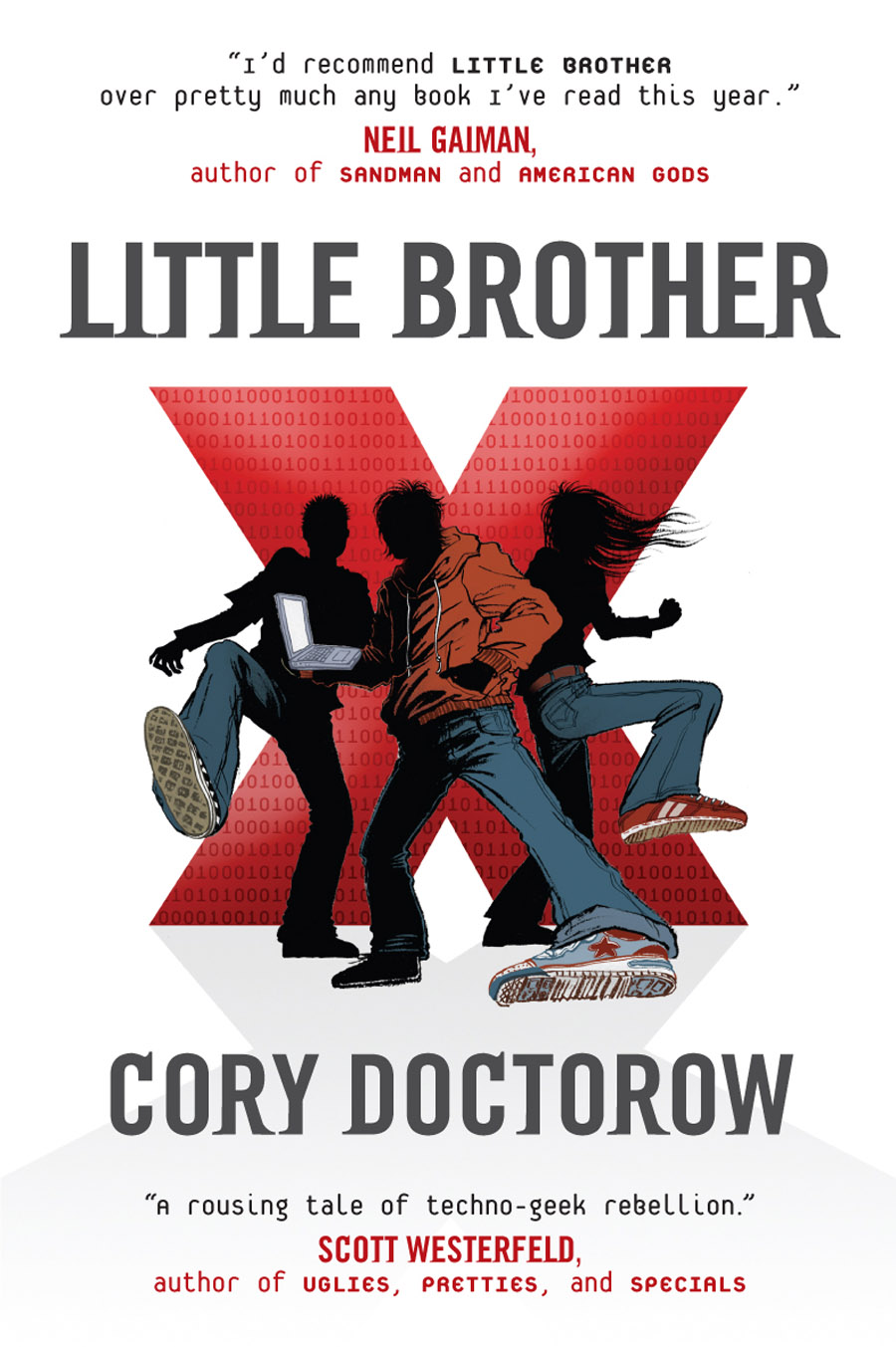Book Review By: Mr. Roboto
Author: Ryan A. Span
Year: 2010
Category: Cyberpunk Books
Website: Street of Eyes
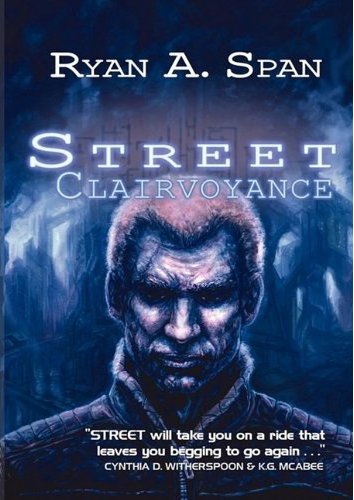
First of, an apology. I had received Ryan’s second Street of Eyes novel back in May. That time period was rather confused with a lay-off, some temporary work, unemployment, then being called back to work, and a reading and review got lost in the shuffle. There’s only one way to describe how I feel for letting this go for so long…
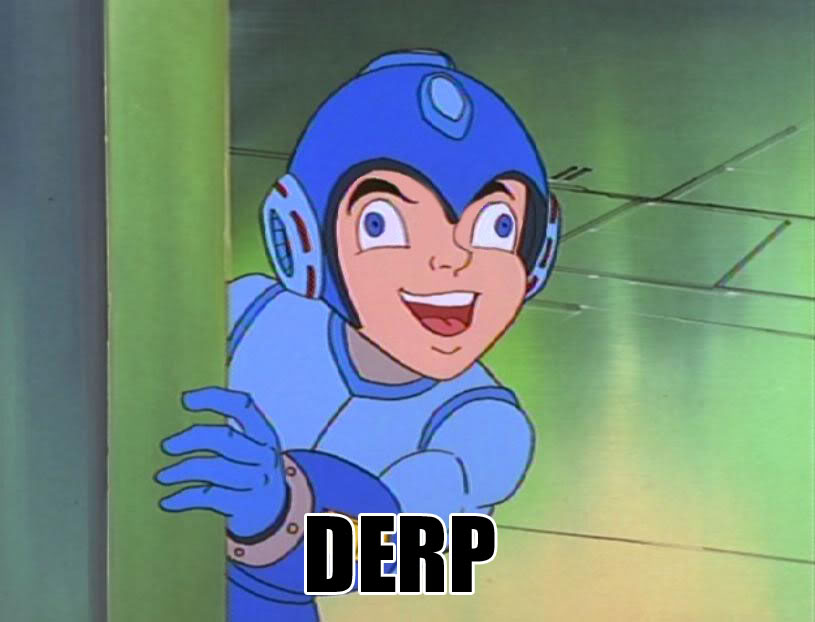
Fortunately, I did manage to cram the entire book into my eyeballs this weekend. I can say that the second Street novel ain’t no huurrr-duuurrr hurpa-derp. What it is is a worthy successor to Empathy that picks up where it left off: With Gina recovering on a Ukraine fishing trawler after her fall from an airship in a lifeboat. She gets to know the ship’s captain, his wife, and the fishing village where the couple live. But her telepathic powers are still in effect, and they have her hopping into the heads/bodies of Rat and Bomber. Soon, Gina wants to leave the simple fishing life and try to find Bomber, fearing Gabriel may have killed him.
Meanwhile, Bomber (now going by Simon Caine) is recovering from jumping out of that same airship. He begins looking for Gina and Gabriel, but needs help from hackers Jock and Rat. Rat is given a unique opportunity: She is invited to be a ranked hacker by working for the lead hacker himself, the King of Laputa. Only she meets another woman who used to be the leader until outed by the current king and is now planning a revolt against what she sees as a “boy’s club” (the Fifteen leaders of the hacker nations).
Past Prologue. For Clairvoyance, we get to learn more about some of the character back-stories. Gina used to be Emily Vaughn, the daughter of a well-to-do family who resented her father’s social climbing by “being a lap dog for the Federation.” Bomber was a US Marine who underwent ID changes as needed. And Gabriel was a survivor of a nuclear attack because of a secret nanotech program. This gives our characters the background that explains their current actions, and a little foreshadowing as those pasts return to haunt them in various ways.
Don’t derp out on volume two. Already, Ryan is working on the third and final Street volume (aka Precognition) on his site. If Clairvoyance is any indication, Precognition should be the magnum opus for the Street series. In the meantime, better get Clairvoyance (and Empathy if you don’t have it yet) to prepare for the grand finale.
This post has been filed under Cyberpunk Books by Mr. Roboto.
Review By: Mr. Roboto
Authors: Dan O’Bannon & Jean “Moebius” Giraud (Illustrator)
Year: First appeared in Metal Hurlant, 1976
Category: Cyberpunk Books; Graphic Novels; Proto-Cyberpunk Media
Another piece of the proto-cyberpunk puzzle is found. So far, proto-cyberpunk media has dealt more with the themes of cyberpunk. But what about the look, that Blade Runner-esque future with stratosphere busting skyscrapers and flying cars? Did Ridley Scott have that vision in his head all along?
NOPE.
As it turns out, there was a major influence that would spark the future visions of Scott and Gibson: A short comic about a private eye (or “nose” as the main character called himself) who is hired to retrieve a package. The story itself isn’t much (too short to call it a novel), but the artwork is what influenced Scott and Gibson.
(From Blade Runner Movie site) “Years later, I was having lunch with Ridley, and when the conversation turned to inspiration, we were both very clear about our debt to the Metal Hurlant [the original Heavy Metal magazine] school of the ’70s–Moebius and the others. “
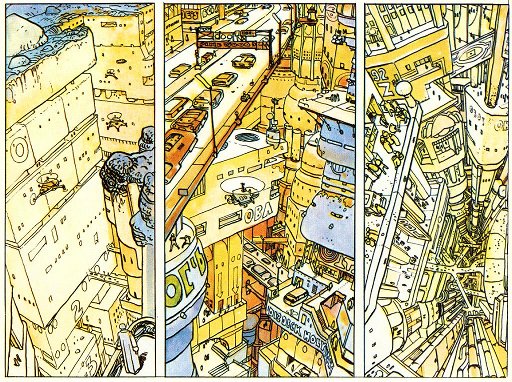
Problem: Metropolis had these city scenes some fifty years earlier! Did Gibson and Scott ever see Metropolis? Apparently not, since they give their props to Moebius:
“So it’s entirely fair to say, and I’ve said it before, that the way Neuromancer-the-novel “looks” was influenced in large part by some of the artwork I saw in ‘Heavy Metal’. I assume that this must also be true of John Carpenter’s ‘Escape from New York’, Ridley Scott’s ‘Blade Runner’”, and all other artefacts of the style sometimes dubbed ‘cyberpunk’. Those French guys, they got their end in early.”
Fritz Lang and the Germans beg to differ.
My advice: Check both out and see who had the future first.
This post has been filed under Proto-Cyberpunk Media, Cyberpunk Books, Graphic Novels by Mr. Roboto.
Review By: Mr. Roboto
Authors: Robert Venditti & Brett Weldele (illustrator)
Year: 2006, 2009
Category: Cyberpunk Books; Graphic Novels
NOTE: This review will cover both graphic novels The Surrogates and The Surrogates: Flesh and Bone.
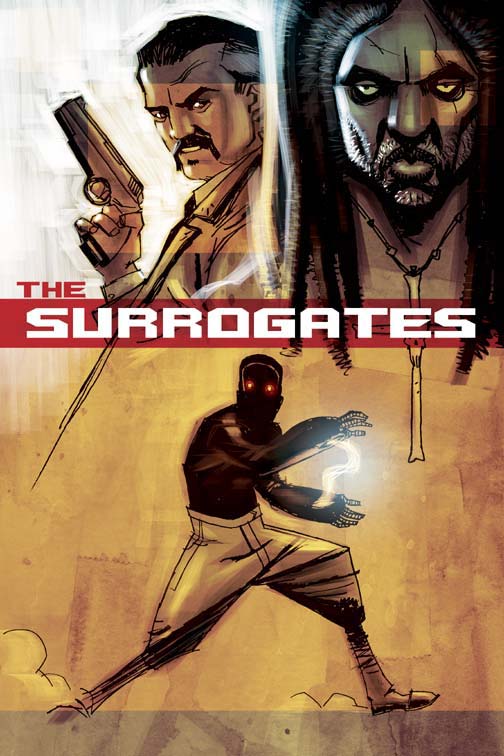
“Live”
Coming to a big screen near you. With the Surrogates movies opening this Friday (Sept. 25), I’d thought we should check out the book that it is based on. Originally a five issue comic, The Surrogates shows life in 2054 Georgia (US) as a police detective searches for a person who is destroying “surrogates,” robotic avatars that people use to interact with the real world from the safety of their homes. There is also a prequel, The Surrogates: Flesh and Bone. The two books are combined into the The Surrogates: Owner’s Manual.
Synopsis: Lieutenant Harvey Greer investigates the destruction of two surrogates that is first attributed to a “flash storm.” A data-recording unit on one of them shows that they were actually destroyed by an electrical discharge from someone or something that would be called the “steeplejack.” Greer suspects that the steeplejack may be working for a religious cult called The Church of The Prophet, aka the “Dreads,” who are known to have a history against surrogates.
As Greer delves deeper into the mystery, his own surrogate is destroyed by the steeplejack, who plans to disable or destroy all the surrogates. Instead of replacing it, he decides to continue without it, and does find who is behind the steeplejack and the anti-surrogate plot.
In the prequel, Flesh and Bone, a homeless black boy is beaten and killed by rich white kids using their parent’s surrogates. This causes the Dreads’ anti-surrogate movement to swell, leading to a riot when the most reliable witness to the beatings is killed before them. After some negotiations, the Dreads are allowed to leave the city and setup a “nation” where they can govern themselves. In this book, Greer is a patrolman waiting to hear back about his detective test.
Back Stories. In between the chapters of ink-on-single color pages come some ephemera that sets a bit of background: A research paper on the benefits of surrogates, a questionnaire, news clippings, and even “pamphlets” from Virtual Self, Inc. (Life… Only Better) and The Church of The Prophet (The Dreads). These add to the story by filling in some back details about how and why the surrogates became so popular and despised. In particular, a news transcript about Zaire Powell III proves quite revealing on how he murdered his baby sister and then set fire to his home killing everyone else. After his release he founded the Dreads movement.
But is it cyberpunk? If you need to ask, you must not be paying attention. I can say with confidence that *YES*, The Surrogates series IS cyberpunk. If the beating at the beginning of Flesh and Bone didn’t beat that point home, consider this: Greer’s wife commits suicide when her surrogate is disabled.
But, there are still some questions left; Will the movie follow the novel(s)? Probably not exactly, but Blade Runner didn’t follow Phillip K. Dick’s novel exactly either. Will the movie be any good? I’ll let you know this weekend…
This post has been filed under Cyberpunk Books, Graphic Novels by Mr. Roboto.
Among the latest in CP. In my last book review (The Shockwave Rider), I covered what is undoubtedly THEE prototype cyberpunk work. Now I give you a recent work from one of Boing Boing’s co-editors, Cory Doctorow, as he tells the story of a tech-savvy teen’s battle with Big Brother in a post 9/11 America. Though targeted to a younger audience, old farts out there should give it read as well.
Synopsis. The story is told through the eyes of Marcus Yallow, aka “w1n5t0n,” a San Francisco gamer who ditches school with his friends to participate in an alternate reality game. Things go bad as a terrorist attack mobilizes the DHS, who kidnap Marcus and company and threaten to “make them disappear” if they tell anyone about their captivity and torture. When an injured friend isn’t released, Marcus wages a personal war against the DHS, who have turned the Bay Area into a police state, by using the various technologies available such as Linux for the Xbox and trusted networking.
A Call To Action. A brief essay from Doctorow about his book shows that Little Brother isn’t just a novel written for entertainment; There’s a definite purpose for the book’s existence:
How do kids figure out which search-engine results to trust? What happens to their Facebook disclosures? How can they tell whether a camera, ID check, or rule is making them safer or less safe? In the absence of the right critical literacy tools, they’ll never know how to read a Wikipedia article so that they can tell if it’s credible. They’ll never know how to keep from ruining their adulthood with the videos they post as a teenager, and they’ll never know when the government is making them safer or less safe.
…
The difference between freedom and totalitarianism comes down to this: do our machines serve us, or control us? We live in the technological age that puts all other technological ages to shame. We are literally covered in technology, it rides in our pockets, pressed to our skin, in our ears, sometimes even implanted in our bodies. If these devices treat us as masters, then there is no limit to what we can achieve. But if they treat us as suspects, then we are doomed, for the jailers have us in a grip that is tighter than any authoritarian fantasy of the Inquisition.
The book was intended to get the youngsters to thinking about their security and privacy in a tech-saturated world of paranoia, and to have them and their parental/guardian/mentor units discuss the point of how to better secure liberty and freedom on this prison planet.
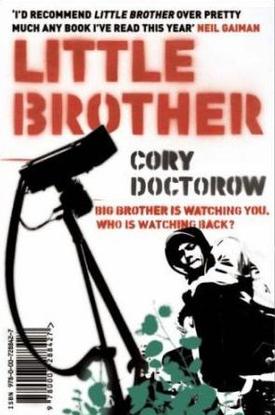
For those in the UK, Cory Doctorow will be @ Forbidden Planet London on November 29, 2008 to sign copies of the UK version of the book. Click the pic above for details.
Conclusion. If you or someone you know is old enough to use technology, or needs to know about the consequences of its usage, this book is a necessary read. With the holidays coming up, this book would be an excellent gift for the hacker, gamer, or net surfer in your tribe. It just might open your eyes to the eyes of Big Brother.
This post has been filed under Cyberpunk Books by Mr. Roboto.
Review By: Mr. Roboto
Author: John Brunner
Year: 1975
Category: Cyberpunk Books; Proto-Cyberpunk Media
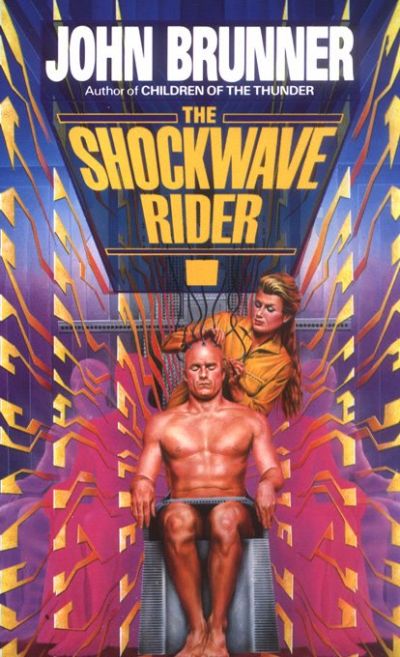
“First we had the legs race. Then we had the arms race. Now we’re going to have the brain race. And, if we’re lucky, the final stage will be the human race.” - Angus Porter
Cyberpunk before cyberpunk. Before the word was ever coined, John Brunner created a world so close to what we now consider to be ‘cyberpunk’ that it needed to be read to be believed. It has a computer network that virtually… and literally… permeates American society, while secret government projects try to squeeze the best minds for all their knowledge to try to monitor a society uprooted by a massive west-coast earthquake. About all that’s missing are the cybernetic implants, although there are bio-engineered people and animals that seem to behave almost human.
What you have is THEE definitive blueprint of cyberpunk, even though nobody knew it for another decade.
Synopsis: The Pacific coast finally experiences “The BIG One” that kills millions and displaces millions more leaving them with nothing to live on except welfare. Meanwhile, the rest of the nation is experiencing their own kind of “overload” as varying levels of data access has left some without a permanent residence while the “privileged” live in their own kind of haven. To help cope (or, more like, to exploit) this flux, the US Government, under control of criminal elements, began programs to identify potentially “gifted” students to cultivate their “wisdom” to further the Government’s cause.
Nicholas Kenton “Nickie” Haflinger is the product of this program. His talents were being wasted in a failed education system where intelligence made you a target of gang violence. At the novel’s start, Nickie is back at his old academy at Tarnover where he is about to undergo a form of interrogation where his memories are replayed on a data-analysis system while he is unconscious. When Nickie was awake, he was subjected to further questioning and moral arguments with Paul T. Freeman, who is another of the program’s “graduates” from a place called “The Electric Skillet.”
Between the regression flashbacks and the moral point/counterpoints, we see how Nickie managed to elude the authorities while making a living (several, actually) using the skills he learned at Tarnover… and why he ran away to begin with.
Now for the good stuff! So, how did Nickie manage to elude capture for so long? Among his skill-set is the ability to program the data-net using nothing more than a touch-tone phone (PHREAKY!). That, and a high-level access code he stole. With these tools, Nickie was able able to quickly change identities to avoid being captured by creating… wait for it…
WORMS!
That’s right, worms! Those self-propagating programs that hog bandwidth are the result of this book. Nickie programmed his worms to erase all traces of his old identity and to create new ones when needed. He also creates a “super worm” that discloses information that the government has been trying to keep secret.
Another proto-cyberpunk classic for your bookshelf. Make some space next to True Names in your library. The Shockwave Rider is a book that must be in your collection.
This post has been filed under Proto-Cyberpunk Media, Cyberpunk Books by Mr. Roboto.
Book Review By: Mr. Roboto
Year: 2003-2004 (?)
Arthur: Marshall Brain
Category: Online Cyberpunk Books
READ IT ONLINE!

‘How Stuff Works,’ Cyberpunk edition. Perhaps better known for his “How Stuff Works” website, Mr. Marshall Brain has since started his own site with some essays and stories. Out of curiosity, I did a search for “cyberpunk” on HowStuffWorks.com and they returned an article on “How Hackers Work,” so he/they seem to have an idea about cyberpunk. Manna also reflects this.
Synopsis. The story is told first-person by Jacob Lewis105, a burger-flipper at Burger-G when, on May 17, 2010, the end began. A simple PC in a back corner of the Burger-G had software installed on it called “Manna” (as in manage) that could micro-manage the workers via voice synthesis through headsets. Before long, other businesses replaced managers with Manna and clones. Eventually, this lead to a two-tiered society of the uber-rich execs and the minimum-wage slaves… until robotic technology advanced to the point where the slavers are no longer required, and a good portion of the human population ended up in unemployment tenement “projects.”
Short, but sweet. Brain’s story is surprisingly good, but the ending did leave me wanting more. I wanted to see if the Manna-net would try to take over the paradise Jacob finds. But for eight “chapters” of 2-3 pages each, it is a good, easy read. If only it was in PDF or some e-text form…
This post has been filed under Internet Find, Cyberpunk Books by Mr. Roboto.
Book Review By: Mr. Roboto
Author: Vernor Vinge
Year: 1981
Category: Cyberpunk Books
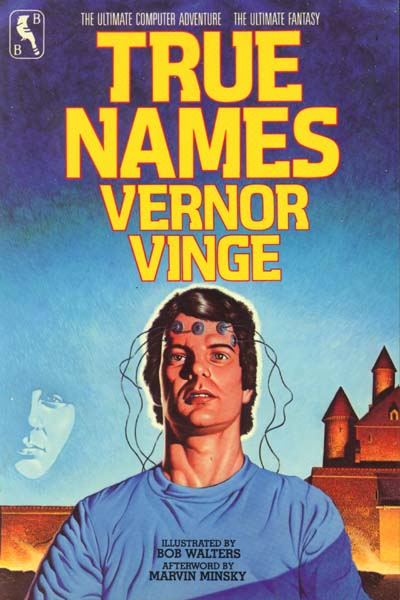
In the once upon a time days of the First Age of Magic, the prudent sorcerer regarded his own true name as his most valued possession but also the greatest threat to his continued good health, for–the stories go–once an enemy, even a weak unskilled enemy, learned the sorcerer’s true name, then routine and widely known spells could destroy or enslave even the most powerful. As times passed, and we graduated to the Age of Reason and thence to the first and second industrial revolutions, such notions were discredited. Now it seems that the Wheel has turned full circle (even if there never really was a First Age) and we are back to worrying about true names again.
This opening paragraph pretty much describes the premise of True Names. This novella, released three years before Neuromancer, gives us a cyberspace adventure that has influenced many a cyberpunk writer… possibly even Gibson himself.
Synopsis: Roger Pollack is a computer wizard who frequents the “Other Plane” as “Mr. Slippery” and has other wizard friends whose “true names” are kept secret, even from each other. He is confronted by agents of “The Great Adversary” (The US Government) who has reason to believe that another wizard named “The Mailman” is recruiting other wizards for some type of coup on the net that can lead to control of reality.
Everything you’d expect from cyberpunk… and then some. The “Other Plane” connects to many nets, nodes, and databases. Anyone who has the ability to connect and control them can become a virtual god, and when Mr. Slippery finds out who… or what… The Mailman is, you’ll understand why this novella is definitely cyberpunk.
Don’t believe me? Read it online. (BIG ACK signal to “The Rectifier,” though I have yet to find the zip file he mentions.) You can still find the story for sale by itself, mostly online, or as part of a collection like True Names & Other Dangers and True Names: And the Opening of the Cyberspace Frontier.
Read it and see how cyberpunk it is!
This post has been filed under Cyberpunk Books by Mr. Roboto.
Book Review By: Mr. Roboto
Author: Richard Morgan
Year: 2002
Category: Cyberpunk Books

The next generation of cyberpunk has arrived… in 2002. Richard K. Morgan’s debut novel has brought forth a new era of cyberpunk literature that has already produced dividends from Ryan Span (Street: Empathy) and Mr. Morgan himself with two sequels and an unrelated book. JIVE Magazine has gone so far as to name him The New King of Cyberpunk Fiction. Even now, a movie is being made from this book (IMDb reference - Empty for now) due to be released in 2009.
Cyberpunk is said to have that “noir” atmosphere about it, borne of hardboiled detective tomes. Altered Carbon takes the noir factor and overclocks it to make it read like a detective novel. Or, maybe it’s a detective novel that takes the cyberpunk factor and overclocks it to make it read like a cyberpunk novel. However you want to look at it, Altered Carbon is a novel that needs to be read, then read several more times.
They wear their stacks on their sleeves. To better understand the premise of the novel, a quick overview of the key technologies featured…
First, you have “sleeves,” cloned bodies for when you die. For the sleeve, there’s the “stack,” a recording device that’s implanted at the base of your brain when you’re born. The stack records and stores your every thought, emotion, sensation, memory, etc. Your digitized brain can then be uploaded to virtuality, or transmitted (”needlecast”) across the galaxy, where a new sleeve awaits your arrival on another planet.
If your meat body dies, the stack is removed and “re-sleeved” (implanted into a new clone body) so you can continue your existence. That’s IF you have the insurance, loving relatives, or a sleeve-fund ready to pay for the new bod. Otherwise, you go into storage, possibly for centuries. Also, the stack itself can be corrupted or outright destroyed, resulting in “real death.” Some are fortunate, and rich, enough to have their stacks backed up like you would back up your hard drives. Backups are done every couple of days, so if your stack is destroyed, the backup is re-sleeved and you loose a day or two of memories. For someone who has the cash, they can have several sleeves at the ready along with a backed up stack, theoretically enabling them to live forever. Those who have lived through several sleeves are known as Methuselahs, or simply “Meths.”
One such Meth is Laurens Bancroft. Bancroft recently had his head destroyed, along with his stack. Because he had a backup of his stack done a couple of days before, he was able to be re-sleeved, but has no memory of the events leading up to his “death.” The police said Bancroft committed suicide, but he doesn’t believe them and hires an outsider to conduct his own investigation. That outsider’s name: Takeshi Lev Kovacs.
The universe through Kovacs’ eyes. Kovacs is a former U.N. “Envoy,” a form of super-soldier who undergoes special spiritual/psychological training to prepare them to adapt new new bodies quickly for interstellar deployment. Often these new bodies are augmented with neuro-chemical implants to enhance their sleeve’s senses and abilities. Because of their training Envoys are banned from holding government jobs on any world and tend to turn to a life of crime upon leaving the corps. Kovacs was serving time in storage for an unspecified crime when he gets needlecast to Earth and re-sleeved as Elias Ryker, a Bay City (San Francisco) cop, to investigate Bancroft’s death.
From the prologue, where Kovacs is killed, to the end of the novel, we get to experience Kovacs’ adventure through his senses. In a way, this book may actually be Kovacs’ stack transmitted back from 500 years in the future. During his investigation, we see how his Envoy training serves him, especially during a particularly nasty torture in virtuality.
Catholics… or How religion poisons the future. An interesting thread in the novel concerns Resolution 653, a case in a U.N. court where a dead Catholic is going to be subpoenaed and made to testify by re-sleeving. The Vatican has decried re-sleeving as blasphemy, claiming that a human soul is not saved on the stack but goes directly to God upon death. About the only good news about this is that Catholics are easy targets for murder, since they won’t be re-sleeved to testify against their attackers.
This book needs to be imprinted upon your stack. If you preferred to read Do Androids Dream of Electric Sheep? over watching Blade Runner, Altered Carbon is something to put on your “must read” list. Just like reading cyberpunk novels? Here you go. Want to see what the next generation of cyberpunk fiction is like? Take a look. Prefer detective novels over cyberpunk? You’re at the wrong site, but Altered Carbon is definitely noir enough for you.
Page 2: Quotable quotes from Altered Carbon –>>
This post has been filed under Cyberpunk Books by Mr. Roboto.
Book Review By: Mr. Roboto
Author: Ryan A. Span
Year: 2008
Category: Cyberpunk Books
Website: Street of Eyes
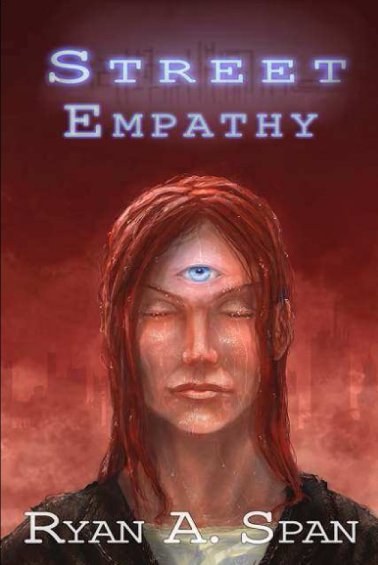
Reports of cyberpunk’s death in literature are premature. Even now, there are writers who have been inspired to write their vision of a techno-dystopic near future, like Mr. Ryan Span (aka “Winter”). His Street Of Eyes website has the serialized version of this soon-to-be released book, and a second book in progress waiting to appear on the site.
Much of what you would expect in cyberpunk literature is here: Hackers, cybernetic soldiers, polluted planet, grim future… along with a couple of (relatively) new elements like telepathy and nanotechnology thrown into the mix. To say Empathy doesn’t bring much new to the table may not be far from the truth, but that doesn’t seem to be the point of the novel. Many have been inspired by the works of Gibson, Sterling, and company, but don’t have the talent… or balls… to put pen to paper (or finger to keyboard these days) and write such works. Ryan Span seems to have the balls to do so, and the talent to make a pretty good story out of it.
The cast of characters. Here now is a brief review of the upcoming dead-tree edition, only with a focus on the main characters to limit spoiling the storyline:
Gina: She works the Street of Eyes as a “telepath-for-hire.” To activate her power, though, she uses a drug called “Spice.” The Spice gives Gina the ability to get into people’s heads, but she needs to be careful about the head she connects to; Users of Spice have been known to go insane when they connect to psychos.
Bomber: He finds Gina on the Street and brings her to his boss. Before long, we find out that he is more than just some gopher for a wealthy client.
Gabriel: The head that Bomber’s boss wants Gina to look into. What she finds there isn’t pretty… but later she falls in love with him.
The Emperor: A Triad (Chinese mafia) lord that Bomber has worked with.
Jock and Rat: Hackers that work for the Emperor. Jock mostly coordinates operations remotely while Rat does the street work. Rat isn’t what he appears to be…

Not quite Neuromancer, but definitely worth reading. While cyberpunk fans wait for the next Neuromancer or Blade Runner to get excited about, Street may be something to pique their interest.
And who knows… in twenty years, somebody may write a cyberpunk novel or film a movie based on Street.
This post has been filed under Cyberpunk Books by Mr. Roboto.
Art Book Review By: Ak!mbo
Author: Otomo Katsuhiro
Year: 2007
Degree of Cyberpunk Visuals: Very high.
Correlation to Cyberpunk Themes: Very high.
Category: Cyberpunk Art Books
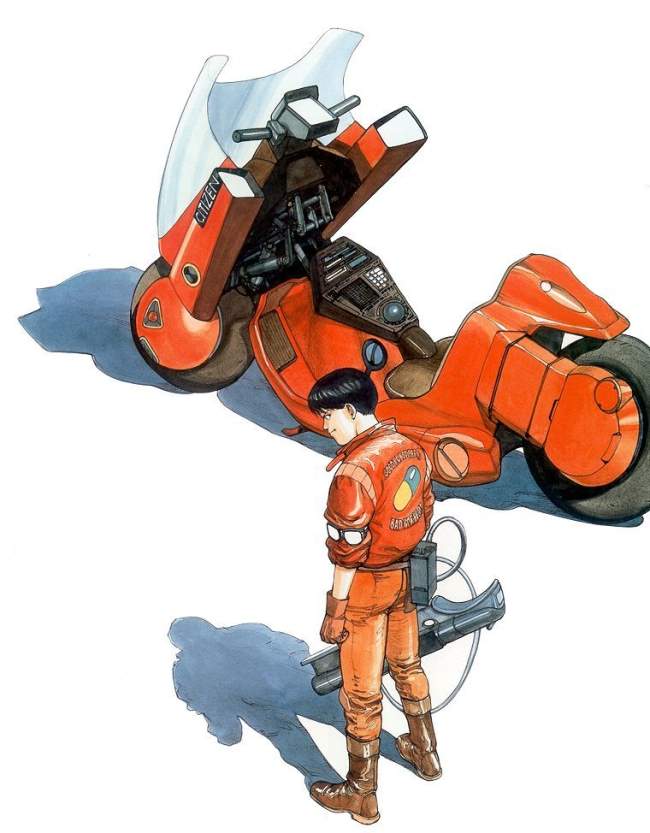
Overview: Akira Club is an art book featuring cover art, sketches and outtakes from the paperback Akira collections. It’s a little pricey at thirty bucks when most the artwork is in black and white, and another set back is the format, which doesn’t match the Akira books. Though mostly presented in black and white, Otomo Katsuhiro’s artwork will blow your socks off. The artwork in Akira Club is incredibly detailed and the author’s commentaries and sketches really show you how much work has been put into the product. While penned many years ago, it doesn’t look a bit outdated. Akira is an epic piece of work at over 2000 pages and has won awards and prestige around the world. The animated movie based on the manga re-introduced the west to Japanese animation in the nineties. The quality of animation mirrors that of the manga and although large parts of the manga were cut from the movie, it still gets the story through to the viewer pretty well.
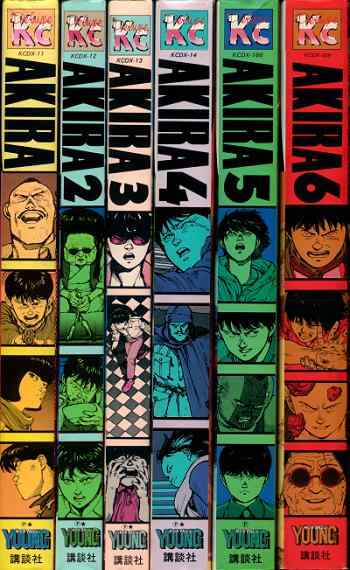
Background: The world of Akira is set after world war three and the destruction and rebuilding of Tokyo. Themes include transhumanism, corruption, low life and high tech and Akira comes across as incredibly cyberpunk, mostly focusing on the life of those on the ground in a super industrialized and militaristic Neo Tokyo. The artwork in Akira Club pretty much represents these themes in great detail. There’s a contrast between the giant, symmetrical skyscrapers which dominate the Neo Tokyo skyline and the life on the ground where there are a lot of organic and seemingly random shapes. There’s also a recurring theme of order put in chaos, like the front cover image; smooth motorcycle parts are jumbled together in a giant mess creating disarray where there once was a finely tuned machine, everything put together neatly.

A lot of the magazine covers show a destroyed Neo Tokyo behind mostly young people. The city being destroyed by a secret weapon created by the government, this gives a pretty strong image of the world being handed over to future generations ruined by our predecessors’ lust for more power through technological advances.

The Sections: The book is divided into four sections:
- Section One: The first section collects several full colour paintings of magazine and book covers, T shirt designs and promotional posters, supplemented with preliminary sketches and short comments from the author; Otomo Katsuhiro.
- Section Two: The second section is the biggest and focuses on the covers used for each chapter when Akira was serialized in Young Magazine. These weren’t included in the paperback collections because they’d break up the natural flow of the story, so having them collected here is kinda nice as the artwork is generally stunning. These do not include comments on the artwork but little musings on life by the author, which I personally found incredibly uninteresting.
- Section Three: The third section collects all sorts of odd artwork used in advertising and merchandise, there’s a lot of great art, but all in all it’s not as interesting as the last section of the book. Also included here are notes on the translation of Akira.
- Section Four: The fourth section is probably the coolest out of the whole book, although I wish it were longer. Titled, “Unpublished Works,” it shows panels and scenes that were never included in the finalized Akira comic books, some pages include parts that were included in the serialized version of the comic, but were cut from the paperback collections.
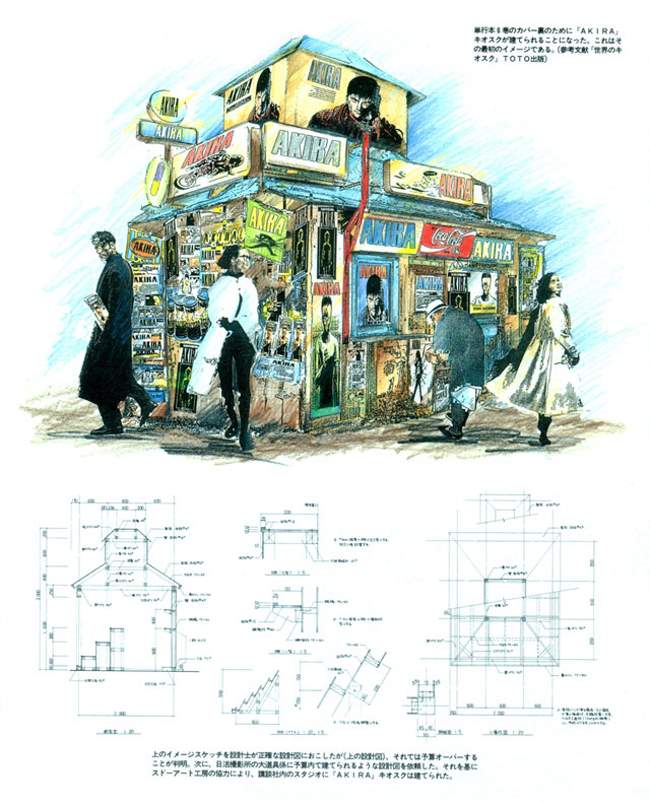
The Bottom Line: Having “read” through the book, I feel a little let down; it’s like there’s something missing. The artwork, though awe-inspiring, is as noted mostly in black and white, and I feel there could have been more colour illustrations put in to compensate for the large number of cover illustrations from Young Magazine. The last part of the book could also have been a little longer. At two thousand pages, I’m sure there is more unpublished material than on display here. I’d like to see the parts excluded from the paperback collections in better detail, preferably in entirety, as I’m sure others are as well. I’ve only had access to the translated collections and would like to know what I’ve been missing out on.
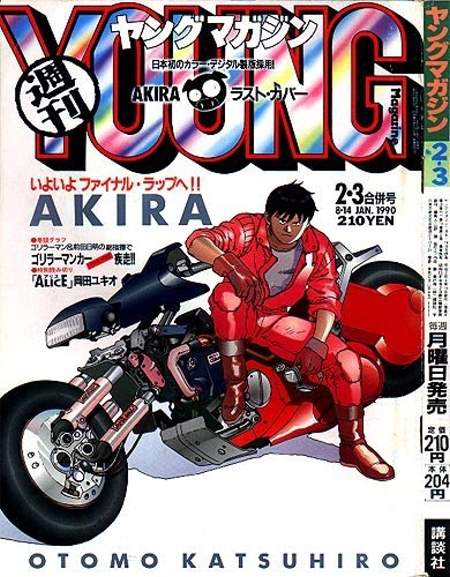
Should You Buy It? All in all, Akira Club is really for those with specialized interests, such as rabid Akira fans, anime historians and artists looking for inspiration in cyberpunk drawings of landscapes and dystopic scenarios. And even for these select few, the book isn’t perfect. However, I think of it as a nice addition to my bookshelf and I browse through it regularly, still “Ooh’ing” and “Aah’ing” at the incredible art. I wouldn’t say this is a must for cyberpunk or indeed Akira fans, but if you think you can afford it, it’s a good purchase and a great gift for those already familiar with the universe and story, be that through the manga or the anime version of Akira.
This post has been filed under Cyberpunk Books, Graphic Novels by Mr. Roboto.
|





